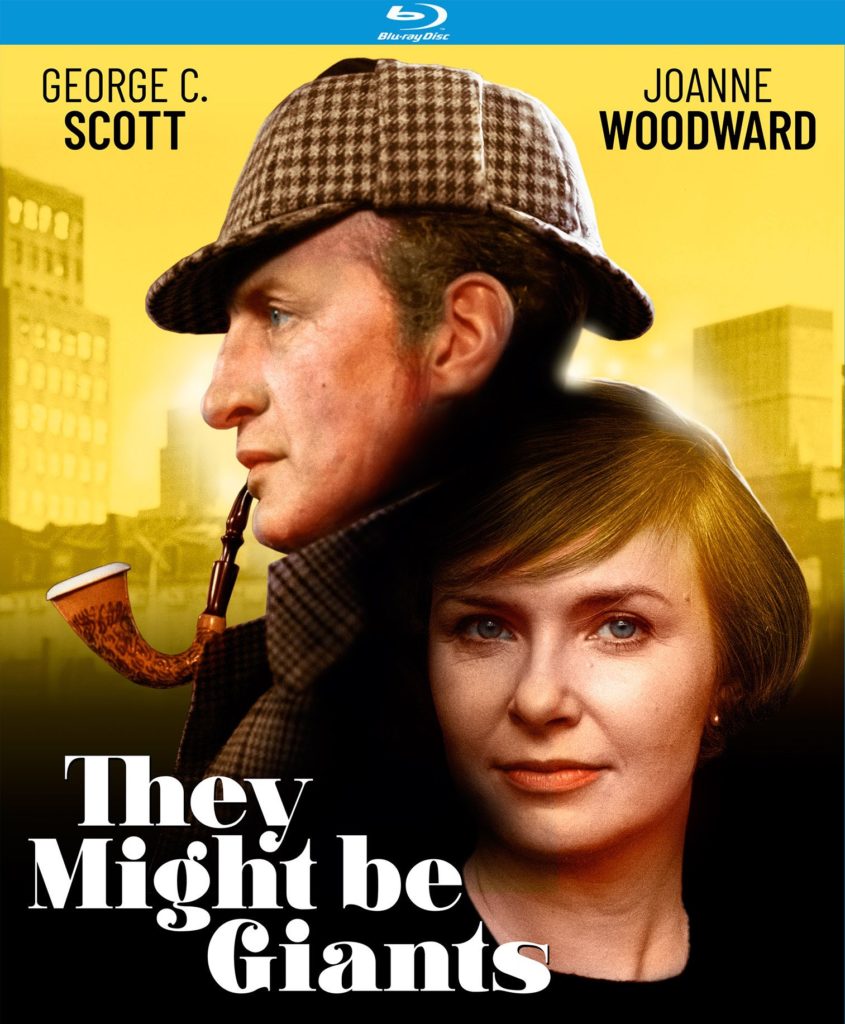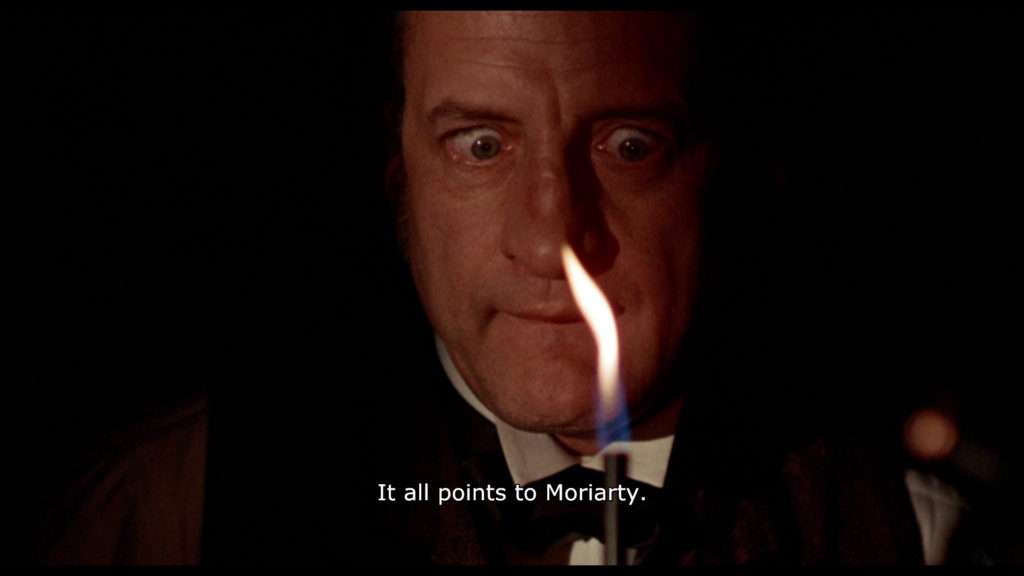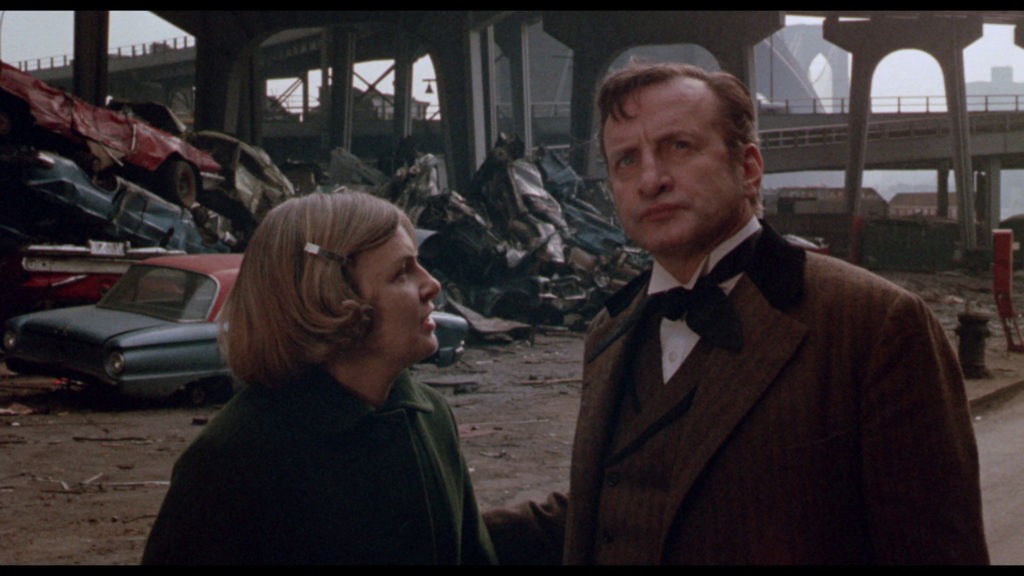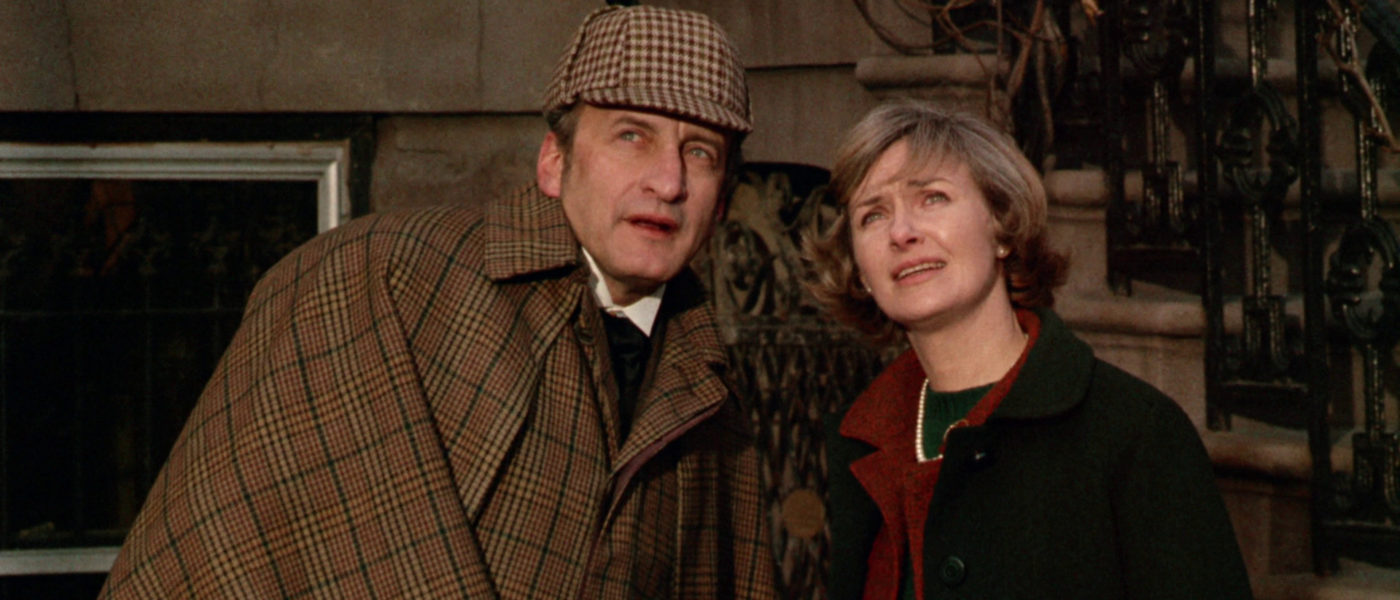Scott And Woodward As Gotham Giants In Loving View of 1970’s Manhattan
1971/DIRECTED BY ANTHONY HARVEY
STREET DATE: June 11th, 2019/KINO LORBER STUDIO CLASSICS

From his 1887 debut — pronouncing “You have been in Afghanistan, I presume” to his future partner, Watson, from a sequence of seemingly invisible clues — Arthur Conan Doyle’s timeless literary creation grew to such immense heights in the popular imagination that he essentially dwarfed his own creator. With that keen glance and deer-stalking cap, meerschaum pipe poised pensively between pursed lips, Sherlock Holmes became the fictional embodiment of the century of reason preceding and the century of progress to follow, convincing many that an actual “consulting detective” resided at 221B Baker Street. Deduction his tool and justice his drive, the Great Investigator righted wrongs and solved the insoluble with the moral certainty of an intellectual superhero. More than mere man, Sherlock Holmes in his finest moments fulfilled the promise — albeit fictionally — of man’s ascending potential.
Thus the title of James Goldman’s 1961’s play. Inspired by Don Quixote’s transforming vision of windmills as looming monsters on the darkling plain, the 1971 filming of the playwright’s own adaptation — concerning a brilliant, justice-driven delusional paranoiac in then present day New York City convinced he is Sherlock Holmes, battling an unseen foe in the evil and omnipresent Dr. Moriarty, treated and in turn joined in the struggle by a female psychiatrist named Dr. Watson — itself inspired the ‘90s alt-rock band whose catchiest song indelibly taught this reviewer’s middle school classmates all about the historical renaming of the ancient Turkish city of Istanbul (not Constantinople). And beyond They Might Be Giants having been entirely shot on location in old New York, which the film’s later namesake band’s biggest hit also reminded us was originally named for a Dutch city (New Amsterdam), it would take a Sherlock Holmes, or at least a Dr. Watson, to explain how the apparently hidden, invisible, and otherwise impossible skyscraping colossi of random trivia — or, indeed, unsolvable clues — might all somehow be connected. The comic-dramatic clash of giants good and bad, real and imagined, and related, relevant, or not, however, is entertaining, funny, and unexpectedly moving.

Formerly distinguished lawyer and state-retired judge Justin Playfair (George C. Scott) fulfills the import and promise of his allegorical-sounding name by having adopted the mantle, mission, and identity of Sherlock Holmes. As the film opens, Playfair’s slimy brother Blevins (Lester Rawlins) seeks to profit off Justin’s schizoid immersion into the persona of the 19th century fictional detective — complete with aforementioned deerstalker and meerschaum — by committing “Holmes” to the untender care of Dr. Freud-bearded Dr. Straus (Ron Weyand). After a forthright, fireworks display of distinctly Holmesian deductive reasoning — and jiu-jitsu — in unmasking the literally silent identity of a fellow delusional named Mr. Small, who believes himself Rudolf Valentino (Oliver Clark), Holmes/Justin attracts the attention of Straus’s dedicated lead therapist Dr. Mildred Watson (Joanne Woodward), who first indulges the self-assumed detective’s relentless search for the elusive, unseen, omnipresent Dr. Moriarty (?) before Holmes/Justin, in learning her identity, decides the female psychiatrist is his own erstwhile assistant, factotum, amanuensis, Dr. Watson.
Beginning with the cutout words “20 grand” pasted to a blackmail note, both are soon caught up in the dogged pursuit of subsequent “clues” across upper Manhattan — continuing citywide through a telephone exchange, a 30-years-closed horticulture school, the upper balcony of a 50-year-old movie palace, and a 24-hour supermarket — and rapidly enact their own Holmes and Watson legend regarding the wretched wronged of the world — including Blevins’s long-suffering yet valiantly perky wife Daisy (Rue McClanahan), a conscience-stricken telephone operator (Theresa Merritt), an anachronistically costumed Westerns movie enthusiast (Sudie Bond), a sadsack reference librarian who dreams of being the Scarlet Pimpernel (Jack Gilford), and many others — before ultimately confronting “Dr. Moriarty” — the progenitor of all evil in the world — emerging from a dark tunnel in Central Park astride a horse near a riding school called, yes, “20 Grand”.

Whether or not one believes the Great Enemy will materialize as the film itself unexpectedly fades, or more accurately brightens, to white may further be immaterial, but certainly those sympathetic to the bewildering game afoot will respond favorably to the many quirky pleasures of They Might Be Giants. Scott and Woodward if not the most traditionally cast among the legion of actor-pairs to play Holmes and Watson — a lineage stretching from Basil Rathbone and Nigel Bruce to Jeremy Brett and Edward Hardwicke up through Benedict Cumberbatch and Martin Freeman — are nevertheless among the most purely enjoyable, the refreshing chemistry of these well-matched actors revealing compelling depths to their mutually humanitarian cause of righting wrongs. Holmes/Scott a decisive, righteous, and indeed inspiring not-so-madman and Watson/Woodward a strong, capable, not-so-scatterbrained modern woman; both enliven and humanize the sometimes cold, distant, stuffily Victorian qualities of that fictionally famous working (and personal) relationship in a manner favorably comparable to Billy Wilder’s near-contemporary and similarly unappreciated character study of The Private Life of Sherlock Holmes (1970).
The true masterstroke of this underseen gem, though, is its time-capsule capture of entirely-on-location-shot exteriors of circa 1970 New York City — from Times Square and Central Park to Broadway and 42nd Street (as an entirely unnecessary but personally relevant parenthetical, a poster advertising a revival of The Front Page starring Robert Ryan that Holmes carefully inspects for clues made me nearly weep with envy for those who could have then seen the production) — to its film-length parade of instantly recognizable but possibly less instantly-named contemporary Gotham stage-and-TV actors — ranging from the aforementioned Gilford, McClanahan, Bond, and Oliver Clark to the yet unmentioned Kitty Winn, F. Murray Abraham, Michael McGuire, Paul Benedict, and M. Emmett Walsh, among several more — which stamp the complete portrayal of its era and setting with an unmistakably authentic appeal. Director Anthony Harvey, in repeated collaboration with screenwriter James Goldman and composer John Barry, again imbues a theatrical property, appreciatively dissimilar from the medieval royal family drama The Lion in Winter (1968), with a similarly genuine and emotional evocation of time and place. We may not believe that giants roam the earth in our everyday lives, but They Might Be Giants is convincing enough in watching to assure us that Holmes and Watson are alive and well in 1970’s Manhattan and that Eden might have once existed beneath its grimy sidewalks and mean streets.
Kino Lorber’s Blu-ray makes a previously hard-to-find title not only re-available but in high definition to boot. A perennial cult favorite to a small but enthusiastic band, one hopes its few but dedicated appreciators may increase in size proportional to the nighttime processional of the disenfranchised Holmes and Watson lead down an intrepid thoroughfare at the film’s climax. Including an older commentary from director Harvey and preservationist (though sadly not for this film) Robert A. Harris, the filmmakers speak at length about the genesis, casting, and production of the film — the latter made for Woodward’s husband Paul Newman’s independent company — before both commentators peter out a bit towards the end with sustained stretches of silent mutual appreciation of the then thirty-year-old film.
Which is absolutely fine. Fifty years on, They Might Be Giants strides tall with its clever, amusing, and often breathtaking compassion for the overlooked, misunderstood, and unappreciated; one further hopes that essential quality makes a gargantuan comeback for the hour-and-a-half of durational viewing time with Kino Lorber’s new Blu-ray. It would, not might, be time well-spent among giants; real, imagined, or otherwise.
The images used in this review are credited to DVDBeaver, and are captured directly from Kino Lorber’s Blu-ray release. Special thanks to Kino Lorber for providing a Blu-ray copy for review.


